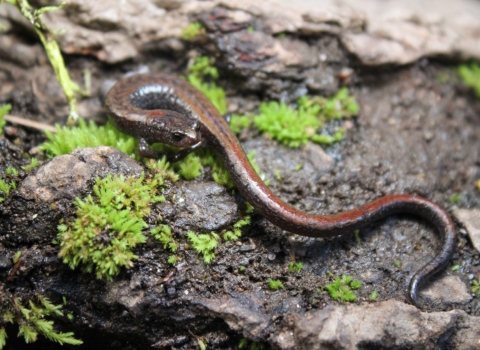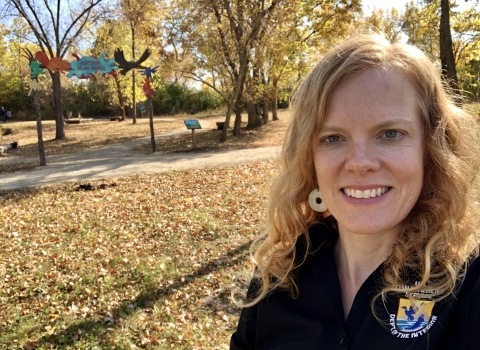BASKING RIDGE, NJ — Secretary of the Interior Sally Jewell joined U.S. Fish and Wildlife Service Director Dan Ashe, Members of Congress and key partners today at Great Swamp National Wildlife Refuge in New Jersey to commemorate the 50th Anniversary of the Wilderness Act and the Land and Water Conservation Fund Act.
Great Swamp was the first unit within the Interior Department to have wilderness designated after President Lyndon Johnson signed the Wilderness Act into law on September 3, 1964. The refuge, like hundreds of other refuges, parks and public lands across the nation, has also acquired a significant portion of its acreage using funding provided by the Land and Water Conservation Fund (LWCF).
“September 3, 1964, when President Johnson signed the Wilderness Act and the Land and Water Conservation Fund Act, is one of the most important days in the history of conservation in this country,” said Secretary Jewell. “We have a moral obligation to future generations to build on this legacy by strengthening the National Wilderness Preservation System and providing full and permanent funding for the Land and Water Conservation Fund.”
In attendance at the event with Secretary Jewell were Service Director Dan Ashe; Congressman Rodney Frelinghuysen of New Jersey; Congressman Rush Holt of New Jersey; Congressman Leonard Lance of New Jersey; Jamie Williams, President of The Wilderness Society; Laura Herrin, Regional Vice President of the Student Conservation Association (SCA); and Rupert Cutler, former assistant secretary Department of Agriculture and senior executive at The Wilderness Society, and a pioneer in the movement to establishment the National Wilderness Preservation System.
Director Ashe noted that the refuge, like many others across the nation, offers an unparalleled opportunity to reconnect urban families with nature and expose children to the wonders of the outdoors.
“Today’s children will be tomorrow’s elected officials, business leaders, parents, and public servants. We need them to value and sustain our wildlife heritage for future generations,” said Ashe. “That won’t happen if they never experience nature or understand the stake they have in healthy wildlife and ecosystems. At Great Swamp and other urban refuges, we have the opportunity to make that connection personal, thanks to the Wilderness Act and Land and Water Conservation Fund.”
Congressman Frelinghuysen, a strong supporter of Great Swamp and wildlife conservation, added his voice to those celebrating the legacy of these conservation landmarks.
“The Wilderness Act is one of our nation's most important pieces of conservation legislation. It is fitting that we mark this important anniversary here at the Great Swamp. The first section of the Great Swamp was designated a National Wildlife Refuge in May 1964 and preserving and protecting the Great Swamp has been an ongoing project ever since. It has grown from its original 2,600 acres to almost 7,800 acres - tripling in size,” he said. “This growth reflects the vision of the people 50 years ago who saved the Great Swamp. It also reflects the dedication and commitment of all those who have worked to expand it and protect it. We must continue to work to safeguard America's natural heritage. It's up to ‘we the people’ to keep places like the Great Swamp preserved and protected for all time.”
Key conservation partners continue to build on that legacy, including The Wilderness Society and the Student Conservation Association.
“The Wilderness Act gave voice to what is collectively America's common ground,” says Jamie Williams, President of The Wilderness Society, founded in 1935 to advocate for protection of America's roadless wild places. “Protected lands and waters only enhance the lives of future generations. The Wilderness Society is here to carry the legacy of our founders forward, reminding our elected leaders that wild places are what help keep America strong, resilient, and economically secure.”
Participants joined an SCA work crew to help clear a trail within the wilderness area wilderness area
Wilderness areas are places untamed by humans. The Wilderness Act of 1964 allows Congress to designate wilderness areas for protection to ensure that America's pristine wild lands will not disappear. Wilderness areas can be part of national wildlife refuges, national parks, national forests or public lands managed by the Bureau of Land Management.
Learn more about wilderness area damaged by Hurricane Sandy, using primitive hand tools to respect wilderness character. The crew has been on the refuge for three weeks working on trail maintenance and clearing.
“Fifty years after the Wilderness Act,” stated Student Conservation Association Regional Vice President Laura Herrin, “SCA and the U.S. Fish and Wildlife Service are advancing that same spirit of stewardship by providing under-served youth with innovative service opportunities that bolster our wild lands and build conservation careers that will reach another fifty years into our future.”
Also, present at the event was the pen used by President Johnson to sign the Wilderness Act and LWCF Act. In the 50 years since, these two laws have supported grassroots conservation efforts across the nation by protecting vulnerable habitat and enabling supporters to acquire land that would otherwise be developed and altered forever.
Today, the National Wilderness Preservation System spans 110 million acres in 44 states, protecting spectacular places in their wild state, where humans are merely visitors. Within these areas, development, road construction and the use of all motorized vehicles and equipment is prohibited.
Over its 50-year history, the LWCF has protected land in every state and supported over 41,000 state and local park projects. LWCF acquisitions protect watersheds and drinking water supplies, preserve our national heritage, and conserve natural areas and open space for wildlife and recreation – all while providing sustainable, domestic jobs in urban and rural communities across America.
Great Swamp was established as the result of a grassroots movement by local citizens to protect their special lands. In the late 1950s, the Port Authority of New York and New Jersey proposed a 10,000-acre airport for this area. Led by a local woman named Helen Fenske, citizens organized to halt the airport development and establish Great Swamp NWR.
However, the Port Authority continued efforts to develop the area — efforts that were only halted by the designation of wilderness within the refuge in 1968. The refuge currently provides primitive recreation opportunities for visitors with 8 miles of trails across 3,660 acres of wilderness — all just 26 miles of Times Square. Nearly a quarter of the refuge has been acquired using LWCF funding.



